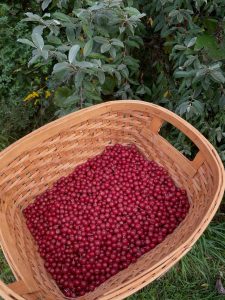
Hairy bittercress(Cardamine hirsuta) and similar species such as Pennsylvania bittercress (Cardamine pensylvanica) are small annual or biennial herbs that are prolific native plants in almost every state in the US. It is a winter annual so it germinates in the fall, stays alive throughout the winter then flowers and puts out seed in the spring.
Despite the name it is usually not bitter, it’s a delicious herb, and the best part, it’s free, you can find it almost anywhere.
Edibility and Culinary Use of Bittercress
The leaves and flower stalks can be eaten raw or cooked. The root can be grated and used as a flavoring. The flavor of this plant is similar to broccoli rabe but much milder. Take a look at this Spicy Bittercress Sautee Recipe. Bittercress is an often overlooked wild edible, but the herby flavor can add some spice to any type of food.
Health Benefits of Bittercress
Being in the Brassica family bittercress has many health benefits. It contains glucosinolates which are known to help remove carcinogens from the body.
It also contains vitamin C, beta-carotene, and possibly lutein which is known to help reduce vision problems including cataracts.
Key ID Features
Bittercress is a lawn weed that is green early in the spring and late in the fall. This is when it is easiest to spot. Here is a list of some of the identifying features of this plant:
1) Circular to 3-lobed small leaves toward the base of the plant which are arranged in a very orderly row along the stem. narrower leaves toward the upper part of the flower stalk which are also arranged in an orderly row along the stem.
2) Leaves and stems come from a single point.
3) Flower stalks with small white flower clusters which turn into small elongated seed pods later in the year.
The best way to identify a plant like this is once you think you have found it, pull it up by the roots and bring it inside to compare to this picture or other pictures from credible sources.
Conclusion
Next time you’re walking through your lawn or garden in the spring or late fall, look for Bittercress and try a little, you might like it. Some people even choose to cultivate it! It’s one of the best leafy green vegetables that grow well in shade.
This small plant can make a big impact for anyone who loves to forage for wild food, or anyone who wants to add another herb to their pantry. It is easy to spot once you know what to look for, and very easy to harvest since there is usually an abundance of plants in one area.
Read our Article on: Safe Foraging
Many of our readers find that subscribing to Eat The Planet is the best way to make sure they don't miss any of our valuable information about wild edibles.
See our privacy policy for more information about ads on this site







2 Responses
I’m so excited I found your wid edible site can’t wait to read more ! I’m so in on keeping our planted free of pesticides! Whoever grows in my lawn stays in my lawn! Waaaahoooo!
Thank you !
I’m so excited I found your wid edible site can’t wait to read more ! I’m so in on keeping our planted free of pesticides! Whoever grows in my lawn stays in my lawn! Waaaahoooo!
Thank you ! Please keep me posted on more edible goodies!